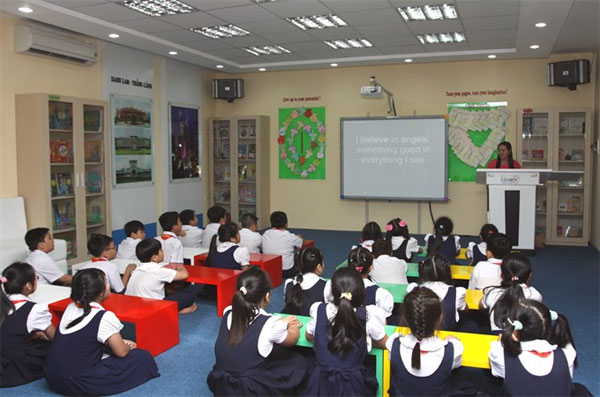[ad_1]
VietNamNet Bridge – A number of schools in HCM City which were named national-standard schools—an honor given to schools that meet criteria ranging from student performance to infrastructure—no longer meet that criteria because their classrooms are too crowded.
 |
|
An English class at Lac Long Quan priary school in HCM City. — VNA/VNS Photo Phuong Vy
|
But even though the schools don’t meet the national standard, they haven’t lost their certificates. According to the Ministry of Education and Training, the national-standard school title is valid for five years. After five years, the schools must be reassessed and the certificate may be withdrawn if they fail to meet the criteria. Officials say that none of the schools in HCM City that won the title, in some cases many years ago, have ever been reassessed.
Lac Long Quan school remains the only primary school among 18 schools in District 11 that has been recognised as a national standard school. When the school received the title in 2000, it had 30 classes with 35 students each, which met the criteria set by Ministry of Education and Training.
Just one year later, however, the school failed to maintain small class sizes due to growth in the student body that wasn’t matched by investment in teachers. The school now has 32 to 36 classes with 39 students each. Though its title has long expired, its certificate still has not been revoked, Thanh Nien (Young People) newspaper reports.
An official of the Education Division of District 11 said that the school is located in a densely populated area. The school prioritises making space for children over maintaining a title, the official said.
Nursery school 27 in Binh Thanh District also had to “break the title” of level 1 national-standard school when it increased the number of students in each class by 10 per cent.
Vu Thi To Loan, the nursery school principal, said, “We cannot keep the title because there are too many children in the area. Nursery schools in neighboring areas are also facing the pressure of population growth. If we do not ‘break the title’, where will children learn?”
Ngo Van Tuyen, head of the Education Division of Binh Tan District, said only two of 22 nursery schools in the district are national-standard schools. Only one of 18 primary schools received the title.
“Each year, there are thousands of students newly enrolling in schools. Each class always has more than 40 students. We do not know when another school might be able to meet the standard,” he said.
According to the city’s Department of Education, 138 out of 1,100 nursery schools, 63 out of 493 primary schools, 19 out of 270 secondary schools and two out of 198 high schools are national-standard schools.
This number is considered low compared to other provinces and cities.
A city education official said that many schools met the criteria relating to teacher quality, but most of them failed to meet criteria for the area of playgrounds, the number of classrooms and the number of students per class.
According to Ngo Van Tuyen, head of Education Division of Binh Tan District, schools in the outskirts have space but are strained by population growth as migrants move towards the city. Schools in the inner city have no space.
Binh Tan District has about 710,000 people, 60 per cent of whom are migrants.
In fact, many schools no longer prioritise winning the title of national-standard school and say they want to focus more on improving the teaching quality.
The principal of a nursery school in Binh Thanh District said that the school had to invest in infrastructure and improve teacher quality to be granted the title. But national-standard schools received funding in the same way as normal ones.
The annual budget for schools depends on the number of students.
Budget cuts hurt teachers’ wages and made it hard to hire additional teachers in order to reduce class sizes to meet the national standard, the nursery school principal said.
|
Criteria for national-standard schools The five criteria are requirements concerning the number of classes and students, active socio-political organisations; qualified staff and managers; education quality (determined by students’ academic performance); infrastructure; and community involvement. There are two levels of national-standard schools. The first level requires schools to ensure comprehensive quality. The second, higher level is given to schools that create conditions for students to match the achievements of their counterparts in advanced countries in the region and in the world. Schools of different kinds will have specific criteria. For example, the first-class national-standards nursery schools must ensure that 100 per cent of teachers and staff meet teaching standards, and at least 40 per cent of teachers must have qualifications that surpass the requirements. – VNS |
Source: VNS
| related news |
[ad_2]
Source link
